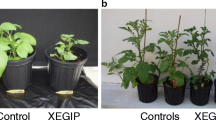Summary
The cost of producing inducible proteinase inhibitors was investigated by manipulating their production with chitin injections in genetically homogeneous tomato plants grown at different nitrogen levels. Proteinase inhibitor production had no detectable effect on fitness-related characters, probably because it represented only a small portion of the nitrogen budget. Nitrogen availability did not influence inhibitor production or its impact on plant fitness.
Similar content being viewed by others
References
Berryman AA (1972) Resistance of conifers to invasion by bark beetle-fungus associations. BioScience 22:598–602
Brighton F, Horne MT (1977) Influence of temperature on cyanogenic polymorphisms. Nature 265:437–438
Broadway RM, Duffey SS (1986) Plant proteinase inhibitors: mechanism of action and effect on the growth and digestive physiology of larval Heliothis zea and Spodoptera exigua. J Insect Physiol 32:827–834
Broadway RM, Duffey SS, Pearce G, Ryan CA (1986) Plant proteinase inhibitors: a defense against herbivorous insects? Entomol Exp Appl 41:33–38
Carroll CR, Hoffman CA (1980) Chemical feeding deterrent mobilized in response to insect herbivory and counteradaptation by Epilachna tredecimnotata. Science 209:414–416
Cates RG (1975) The interface between slugs and wild ginger: some evolutionary aspects. Ecology 56:391–400
Chew FS, Rodman JE (1979) Plant resources for chemical defense. In: Rosenthal GA, Janzen DH (eds) Herbivores: their interaction with secondary plant metabolites. Academic Press, Orlando, pp 271–307
Coley PD (1983) Herbivory and defensive characteristics of tree species in a lowland tropical forest. Ecol Mongr 53:209–233
Coley PD (1986) Costs and benefits of defense by tannins in a neotropical tree. Oecologia (Berlin) 70:238–241
Coley PD, Bryant JP, Chapin FS III (1985) Resource availability and plant antiherbivore defense. Science 230:895–899
Daday H (1965) Gene frequencies in wild populations of Trifolium repens L. IV. mechanism of natural selection. Heredity 20:355–365
Dillon PH, Lowrie S, McKey D (1983) Disarming the “evil woman”! Petiole constriction by a sphingid larva circumvents mechanical deferences of its host plant, Cnidoscolus urnes (Euphorbiaceae). Biotropica 15:112–116
Edwards PJ, Wratten SD, Cox H (1985) Wound-induced changes in the acceptability of tomato to larvae of Spodoptera littoralis: a laboratory bioassay. Ecol Entomol 10:155–158
Foulds W, Grime JP (1972) The response of cyanogenic and acyanogenic phenotypes of Trifolium repens to soil moisture supply. Heredity 28:181–187
Graham JS, Pearce G, Merryweather J, Titani K, Ericsson L, Ryan CA (1985) Wound-induced proteinase inhibitors from tomato leaves I: the cDNA-deduced primary structure of pre-inhibitor I and its post-translational processing. J Biol Chem 260:6555–6560
Green TR, Ryan CA (1972) Wound-induced proteinase inhibitor in plant leaves: a possible defense mechanism against insects. Science 175:776–777
Gulmon SL, Mooney HA (1986) Costs of defense and their effects on plant productivity. In: Givnish TJ (ed) On the Economy of Plant Form and Function. Cambridge University Press, pp 681–698
Gustafson G, Ryan CA (1976) Specificity of protein turnover in tomato leaves: accumulation of proteinase inhibitors, induced with the wound hormone, PIIF. J Biol Chem 251:7004–7010
Hanover JW (1966) Genetics of terpenes. I. gene control of monoterpene levels in Pinus monticola Dougl. Heredity 21:73–84
Jones DA (1962) Selective eating of the acyanogenic form of the plant Lotus corniculatus L. by various animals. Nature 193:1109–1110
Jones DA, Keymer RJ, Ellis WM (1978) Cyanogenesis in plants and animal feeding. In: Harborne JB (ed) Biochemical aspects of plant and animal coevolution. Academic Press, New York, pp 21–34
Krischik VA, Denno RF (1983) Individual, population, and geographic graphic patterns in plant defense. In: Denno RF, McClure MS (eds) Variable plants and herbivores in natural and managed systems. Academic Press, New York, pp 463–512
Kuc J (1982) Induced immunity to plant disease. BioScience 32:854–860
Kyan CA (1967) Quantitative determination of soluble cellular proteins by radial diffusion in agar gels containing antibodies. Anal Biochem 19:434–440
Ryan CA (1978) Proteinase inhibitors in plant leaves: a biochemical model for pest-induced natural plant protection. Trends Biochem Sci 5:148–150
Ryan CA, Green TR (1974) Proteinase inhibitors in natural plant protection. Recent Adv Phytochem 8:123–140
Ryan CA, Bishop PD, Graham JS, Broadway RM, Duffey SS (1986) Plant and fungal cell wall fragments activate expression of proteinase inhibitor genes for plant defense. J Chem Ecol 12:1025–1036
Simms EL, Rausher MD (1987) Costs and benefits of plant resistance to herbivory. Am Nat 130:570–581
Tallamy DW (1985) Squash beetle feeding behavior: an adaptation against induced cucurbit defenses. Ecology 66:1574–1579
Walker-Simmons M, Ryan CA (1984) Proteinase inhibitor synthesis in tomato leaves: induction by chitosan oligomers and chemically modified chitosan and chitin. Plant Physiol 76:787–790
Weisberg S (1980) Applied linear regression. Wiley, New York USA
Windle PN, Franz EH (1979) The effects of insect parasitism on plant competition: greenbugs and barley. Ecology 60:521–529
Author information
Authors and Affiliations
Rights and permissions
About this article
Cite this article
Brown, D.G. The cost of plant defense: an experimental analysis with inducible proteinase inhibitors in tomato. Oecologia 76, 467–470 (1988). https://doi.org/10.1007/BF00377044
Received:
Issue Date:
DOI: https://doi.org/10.1007/BF00377044




